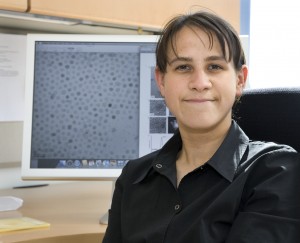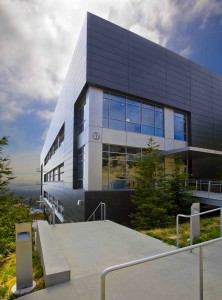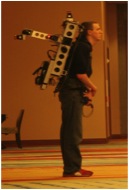Two Lawrence Berkeley National Laboratory (Berkeley Lab) research projects were awarded grants by the Department of Energy’s Advanced Research Projects Agency-Energy (ARPA-E) to advance energy technologies. The two grants total nearly $5 million.
The first grant of $3 million went to the Molecular Foundry’s Delia Milliron for her work on smart window technologies. The project will seek to enhance the energy efficiency of buildings through advanced electrochromic windows with improved performance and low cost.
The second grant focuses on the creation of a system to “map” a building’s thermal use leading to more efficient design and construction. That grant is led by Environmental Energy Technology Division’s Philip Haves and is supported by $1.94 million from ARPA-E.
On November 28, Energy Secretary Steven Chu announced 66 cutting-edge research projects selected by ARPA-E to receive a total of $130 million in funding through its “OPEN 2012” program.
ARPA-E seeks out transformational, breakthrough technologies that show fundamental technical promise but are too early for private-sector investment. These projects have the potential to produce game-changing breakthroughs in energy technology, form the foundation for entirely new industries, and could have large commercial impacts.
The “Low Cost Solution Processed Universal Smart Window Coatings” project, awarded $3 million in ARPA-E funding, is a collaborative effort between Milliron’s research group at the Molecular Foundry and scientists in Berkeley Lab’s Environmental Energy Technologies Division (EETD), in partnership with Heliotrope Technologies. The team aims to develop a new electrochromic window coating technology, which can respond to changing weather conditions by regulating the amounts of visible light and heat permitted to enter a building, dramatically reducing energy usage. Electrochromics currently on the market lack this flexibility and are prohibitively expensive. This project promises to address both of these issues, resulting in a new window that is scalable for manufacturing and affordable enough to stimulate widespread adoption.
“The ARPA-E proposal review process is highly competitive and selects for innovative concepts with the potential for major impact on the energy landscape. It is a real privilege to be awarded this grant,” says Milliron, Molecular Foundry Deputy Director and Principal Investigator of the electrochromic smart window project.
This new window coating will respond to a small, applied voltage to vary the transmittance of visible light and heat-producing near-infrared radiation (NIR). In this way, the sun’s power can be harnessed to permit maximal light and heat to enter in cold weather, while preventing unwanted heating and glare on hot, sunny days. Ultimately, such dynamic windows would be integrated with an intelligent control system to maximize energy savings and make buildings more comfortable.
This new ARPA-E project has its roots in a collaborative endeavor of Berkeley Lab researchers working across divisions to seek out new approaches to improve building energy efficiency. Milliron’s group previously worked with EETD scientists and ARPA-E co-PIs Stephen Selkowitz and Arman Shehabi to discover that nanocrystal films can selectively modulate the transmittance of NIR while maintaining visible transparency and to analyze the energy savings potential of such spectrally selective electrochromic coatings if deployed across the US. This new optical effect relies on the changes induced in the nanocrystals’ plasmonic properties upon the application of a small jolt of electricity. Now this team will work together to improve the performance of these materials and demonstrate scalable methods for manufacturing window coatings based on this principle.
“In addition to improving coating functionality, our technology utilizes a solution processing technique that will transfer well to large scale manufacturing. This makes commercial production practical and window cost affordable,” says Guillermo Garcia Chief Technology Officer and co-founder of Heliotrope Technologies, a start-up company working with Berkeley Lab to develop the dynamic window coatings.
“The ARPA-E initiative is a unique, highly competitive funding opportunity that allows for exploration of truly groundbreaking innovations,” says Molecular Foundry Director Omar Yaghi. “It is a pleasure to see yet another example of how the Foundry is successfully threading scientists and users with innovative ideas and research.”
Three-dimensional maps of commercial buildings improve energy efficiency
The second ARPA-E grant of $1.9 million is for the “Automated Modeling and Simulation of Existing Buildings for Energy Efficiency” project led by Berkeley Lab’s Philip Haves. Haves, leader of EETD’s Simulation Research Group, will lead a project to develop the sensing and computer hardware for generating physical and thermal maps of the interiors of buildings. The goal is to reduce the energy consumption of existing commercial buildings through computer simulation of building energy use.
“To do this, and do it in a lot of buildings, we need better, cheaper, faster ways to generate computer models of the buildings we want to improve,” says Haves. He and his team plan to produce three-dimensional indoor maps of buildings using cameras and laser scanners, transferring this data to building simulation software. The cameras and scanners will be mounted on a backpack; a person wearing the instrument package will walk through the rooms in the building to make a video of the building’s interior and exterior. A computer will then turn this video into a digital model of the building.
The computer simulations will allow building architects and engineers to design more energy-efficient buildings. Building simulations can help increase energy efficiency by identifying how a building is failing and what maintenance staff can do to tune up its energy-consuming systems, suggesting equipment upgrades for better energy performance, and ensuring that improvements are installed correctly and are delivering the expected energy savings.
Berkeley Lab’s team is collaborating with UC Berkeley Professor Avideh Zakhor, who leads the Video and Image Processing Lab in the Electrical Engineering and Computer Science Department, and Oliver Baumann of Ebert & Baumann Consulting Engineers in DC. The image processing techniques and the prototype backpack have been developed by Zakhor’s group.
Haves believes this technology can reduce the cost of building simulation by 30 to 40 percent, as well as the time it takes to develop a building model.
# # #
Lawrence Berkeley National Laboratory (Berkeley Lab) addresses the world’s most urgent scientific challenges by advancing sustainable energy, protecting human health, creating new materials, and revealing the origin and fate of the universe. Founded in 1931, Berkeley Lab’s scientific expertise has been recognized with 13 Nobel prizes. The University of California manages Berkeley Lab for the U.S. Department of Energy’s Office of Science. For more, visit www.lbl.gov.



